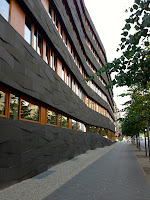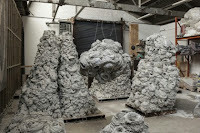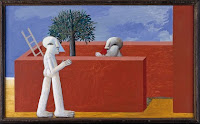BERLIN - BURSTING WITH ENERGY AND ELEGANCE
There have been many business trips to Berlin but none I remember when I actually walked around the city. This was to be different. I was meeting up with perhaps my oldest friend who was there from Australia. A Berliner. What I do remember are the university lectures I gave for years on «International Distribution of Cosmetics». Berlin I knew for its major shopping centres and that since the war it was a city under construction. It still is. Perhaps not as I remember it but now that the east and west have joined the number of buildings being put up or pulled down is still awesome.
KaDeWe - the largest department store was still as chic as ever. Now there was a Galeries Lafayette and inside it is unmistakable.
I had chosen a hotel in the Eastern part, a few minutes walk from Checkpoint Charlie. There is this extraordinary curiosity about Hitler and people queue to go into one of the historical museums on that period.
Maybe it’s not a good description but the Eastern block has the left bank atmosphere of Paris and the western our right side bourgeoisie. Berlin is a beautiful city. Humming with energy and elegance. Trees keep the city cool. In actual fact it could be described as a large and beautiful garden. Despite the 35°, there was no humidity and we walked - and we walked.....the relationship between old and new buildings give the city an energy. Nothing seems to be out of place. Even the really modern Hauptbahnhof was a spectacular building.
Bears were all over the place. I was told that there had
been a large sculpture exhibition with the same and I gather many stayed
in place. A bit kitch in my book.
We walked around the quartier where he had lived as a child. Following his description his world came alive for me even if most of the area in question had been heavily bombed during the war. I have never seen a church tower as tall as this.
By the time I left I knew where I was going in the
central part of Berlin, could take a bus or the U-bahn and go in the
right direction and even thanks to Mario, the difference between the
north and the south.
One of the reasons I had chosen the hotel was that it was close to the Martin-Gropius-Bau. A Renaissance building which is said to be one of the finest in Berlin.
An Anish Kapoor exhibition was on. The last time I had seen anything important of his was the construction at Monumenta in the Grand Palais in 2011. Or a retrospective of his work in London in 2009. There had been structures too in the Guggenheim (Bilbao), or in Lisbon and Montreal.
Kapoor (Indian and now living in London) is one of the world’s most important contemporary artists. In his objects, the boundaries between sculptures and installations becomes blurred. He had the whole of the ground floor of the Martin-Gropius-Bau for this first major exhibition in Berlin with some of his work designed especially for the venue. It comprises about 70 works over viewing the abstract and poetic. His work is usually monochrome and quite often red pigments are used.
I have never understood how he «constructs» his mirrors. Either your physical state is quite deformed, or you only see yourself and not other people around you. Perhaps you are tripled or turned upside down.
His shooting machines are spectacular. As I was there when the museum opened, there were few of us to see one in action. Indispensable to wear a cask. The «boom» was ear splitting. A few hours later when I heard it again in another part of the museum, even then, three floors up, is was deafening.
His is another world.
To my surprise and joy, there were two other exhibitions at the same museum I could see. One of course with Paul Klee. But who was Itten? A simple title «Itten-Klee: The Cosmos of Colour». And Antes? Once again and artist I knew nothing about.
Hortes Antes is a graphic artist, sculptor and considered to be one of the pioneers of the new figurative scene in Germany. He is probably known for his artificial figure «Kopffüffler (Head footer) - I don’t remember seeing any of his work even if he is internationally known. The exhibition covered five decades encompassing some 90 works. A first major dedicated exhibition of his painting for over 20 years.
This monumental figure seems related to Fernando Botero’s work which amuses me but not more than that. Antes is much more abstract in his approach but even so, his figures are giant size making the colour jump into place. His work is memorable of course and if I see him again in other parts of the world, I will recognize it at once. Or I hope so!
Three hours had gone by. Could I cope with Itten-Klee?
Badly so.
I was at saturation point and only wish I had gone back again before I left. An hour was not enough to take in such a complexe study. Both Johannes Itten (1888-1967) and Paul Klee (1879-1940) made their mark in history of 20th century art with theories on colour that were both significant and prominent. Both were driven by the concept that the organisation of colours is structured in accordance with laws and the internally consistent cosmos. This was very much like a much read book at home on Kandinsky’s «On the Spiritual in Art» (1912), so the three artists were working on such discovereis at around the same time. Kandinsky’s written work has certainly influenced my way of looking at abstraction.
Recent studies reveal that both artists drew inspiration from the same sources and were mutually influential. The theories were developed over years of reflection and studies making profound use of their own works. The exhibition holds 170 key paintings from both artists organized in such a way that the spectator can see how they used their colour. I’m sad that I didn’t get back to see it as after an hour, I no longer saw colour - I no longer saw anything.
Basel and Berlin had been wonderful interludes. Of course I’ll go back to Basel as there are so many good exhibitions to see. Now I can add Berlin to my list as well.
 |
| A New ministry |
 |
| All over the place |
 |
| Over to the Parliment |
 |
| How do I get to the other side? |
 |
| And more construction |
 |
| Inside G.L. |
KaDeWe - the largest department store was still as chic as ever. Now there was a Galeries Lafayette and inside it is unmistakable.
I had chosen a hotel in the Eastern part, a few minutes walk from Checkpoint Charlie. There is this extraordinary curiosity about Hitler and people queue to go into one of the historical museums on that period.
 |
| At Checkpoint Charlie |
 |
| Looking at the wall and a permanent exhibition |
 |
| The balloon became a land mark for me |
Maybe it’s not a good description but the Eastern block has the left bank atmosphere of Paris and the western our right side bourgeoisie. Berlin is a beautiful city. Humming with energy and elegance. Trees keep the city cool. In actual fact it could be described as a large and beautiful garden. Despite the 35°, there was no humidity and we walked - and we walked.....the relationship between old and new buildings give the city an energy. Nothing seems to be out of place. Even the really modern Hauptbahnhof was a spectacular building.
 |
| Looking down inside the station |
 |
| The Concert Hall |
 |
| The French Dome |
 |
| Another view |
 |
| The French dome |
 |
| Oh Well..... |
 |
| Russian Embassy gates |
 |
| The Russian Embassy |
 |
| More construction to cross |
 |
| A residential bear |
 |
| Throwing his money away |
We walked around the quartier where he had lived as a child. Following his description his world came alive for me even if most of the area in question had been heavily bombed during the war. I have never seen a church tower as tall as this.
 |
| Very imposing |
 |
| The Prior's residence |
 |
 |
| Memory lane |
 |
| A tiger like cat watching us |
 |
 |
| Trees which were not cut down |
 |
| An original sign |
 |
| Martin-Gropius-Bau |
One of the reasons I had chosen the hotel was that it was close to the Martin-Gropius-Bau. A Renaissance building which is said to be one of the finest in Berlin.
An Anish Kapoor exhibition was on. The last time I had seen anything important of his was the construction at Monumenta in the Grand Palais in 2011. Or a retrospective of his work in London in 2009. There had been structures too in the Guggenheim (Bilbao), or in Lisbon and Montreal.
 |
| Monumenta in Paris - Kapoor |
 |
| Grand Palais in Paris |
 |
| Inside Monumenta in Paris in 2011 |
 |
| Artist's studio |
Kapoor (Indian and now living in London) is one of the world’s most important contemporary artists. In his objects, the boundaries between sculptures and installations becomes blurred. He had the whole of the ground floor of the Martin-Gropius-Bau for this first major exhibition in Berlin with some of his work designed especially for the venue. It comprises about 70 works over viewing the abstract and poetic. His work is usually monochrome and quite often red pigments are used.
I have never understood how he «constructs» his mirrors. Either your physical state is quite deformed, or you only see yourself and not other people around you. Perhaps you are tripled or turned upside down.
 |
| mirrors 2012 |
 |
| Partly distorted |
His shooting machines are spectacular. As I was there when the museum opened, there were few of us to see one in action. Indispensable to wear a cask. The «boom» was ear splitting. A few hours later when I heard it again in another part of the museum, even then, three floors up, is was deafening.
 |
| Preparation |
 |
| About to fire |
 |
| Into the corner |
 |
| And boom "Shooting in the Corner" |
 |
| Death of Leviathan |
 |
| First body |
 |
| Symphony for a Beloved Sun |
 |
| looking through first body |
 |
| wax scultupres |
 |
| Wax sculptures |
His is another world.
To my surprise and joy, there were two other exhibitions at the same museum I could see. One of course with Paul Klee. But who was Itten? A simple title «Itten-Klee: The Cosmos of Colour». And Antes? Once again and artist I knew nothing about.
Hortes Antes is a graphic artist, sculptor and considered to be one of the pioneers of the new figurative scene in Germany. He is probably known for his artificial figure «Kopffüffler (Head footer) - I don’t remember seeing any of his work even if he is internationally known. The exhibition covered five decades encompassing some 90 works. A first major dedicated exhibition of his painting for over 20 years.
This monumental figure seems related to Fernando Botero’s work which amuses me but not more than that. Antes is much more abstract in his approach but even so, his figures are giant size making the colour jump into place. His work is memorable of course and if I see him again in other parts of the world, I will recognize it at once. Or I hope so!
 |
| Figure with glass and egg. 1971 |
 |
| Blue figure 1962 |
 |
| Black-white 1967 |
 |
| For alomea, 1973 |
 |
| Eva 1973 |
 |
| Portrait Arcimboldo 1973 |
 |
| Ikarus, 1975 - |
Three hours had gone by. Could I cope with Itten-Klee?
Badly so.
I was at saturation point and only wish I had gone back again before I left. An hour was not enough to take in such a complexe study. Both Johannes Itten (1888-1967) and Paul Klee (1879-1940) made their mark in history of 20th century art with theories on colour that were both significant and prominent. Both were driven by the concept that the organisation of colours is structured in accordance with laws and the internally consistent cosmos. This was very much like a much read book at home on Kandinsky’s «On the Spiritual in Art» (1912), so the three artists were working on such discovereis at around the same time. Kandinsky’s written work has certainly influenced my way of looking at abstraction.
Recent studies reveal that both artists drew inspiration from the same sources and were mutually influential. The theories were developed over years of reflection and studies making profound use of their own works. The exhibition holds 170 key paintings from both artists organized in such a way that the spectator can see how they used their colour. I’m sad that I didn’t get back to see it as after an hour, I no longer saw colour - I no longer saw anything.
 |
| P.Klee Nile legend 1937 |
 |
| Johannes Itten, The encounter 1916. |
 |
| Reconstruction Light Tower 1920 - Itten |
 |
| Before Spring 1966 Klee |
 |
| Johannes Itten: Velum composition 1938 |
 |
| After the rain on Plants 1935 - P.K. |
 |
| Paul Klee Frau GL. 1929-39 |
Basel and Berlin had been wonderful interludes. Of course I’ll go back to Basel as there are so many good exhibitions to see. Now I can add Berlin to my list as well.



Commentaires